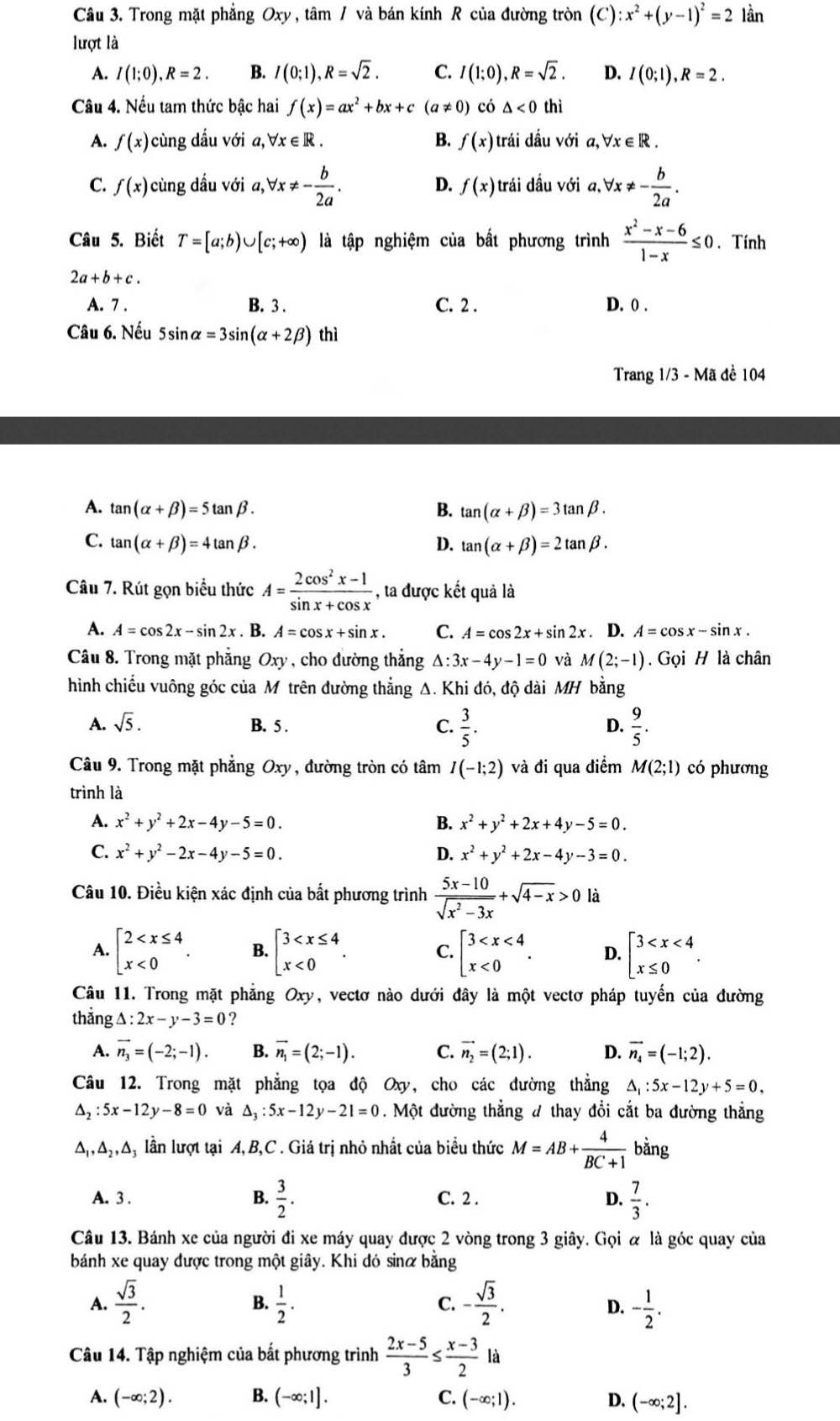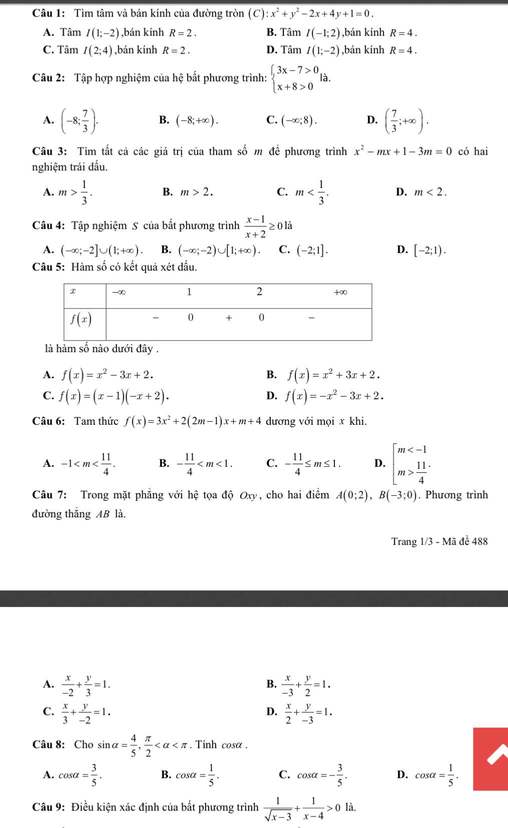
Hãy nhập câu hỏi của bạn vào đây, nếu là tài khoản VIP, bạn sẽ được ưu tiên trả lời.



Câu 2 : C
Câu 3 : A
Câu 4 : C
Câu 5 : C
Câu 6 : B
Câu 7 : C
Câu 8 : D
Câu 9 : B
Câu 2: C
Pt\(\Leftrightarrow\left\{{}\begin{matrix}x-2\ge0\\x^2+5x-2=\left(x-2\right)^2\end{matrix}\right.\)\(\Leftrightarrow\left\{{}\begin{matrix}x\ge2\\9x=6\end{matrix}\right.\)\(\Leftrightarrow\left\{{}\begin{matrix}x\ge2\\x=\dfrac{6}{9}\end{matrix}\right.\)\(\Rightarrow x\in\varnothing\)
Câu 3: A
\(\Delta:3x+4y-11=0\)
\(d_{\left(M;\Delta\right)}=\dfrac{\left|3.1+4.-1-11\right|}{\sqrt{3^2+4^2}}=\dfrac{12}{5}\)
Câu 4: Ko có đ/a
Do \(\dfrac{\pi}{2}< \alpha< \pi\Rightarrow tan\alpha< 0;cot\alpha< 0;cos\alpha< 0\)
\(1+cot^2\alpha=\dfrac{1}{sin^2\alpha}\)\(\Rightarrow cot\alpha=\dfrac{-\sqrt{21}}{2}\)
Câu 5:C
Câu 6:B
Câu 7: A
Có nghiệm khi \(\left(m;+\infty\right)\cup\left[-2;2\right]\ne\varnothing\)
\(\Leftrightarrow m< 2\)
Câu 8:D
Câu 9: B
\(cos2\alpha=2cos^2\alpha-1=-\dfrac{23}{25}\)
Câu 10:D


3.
Do \(sin\left(x+k2\pi\right)=sinx\Rightarrow sin\left(x+2020\pi\right)=sinx\)
\(sin\left(\dfrac{\pi}{2}+x\right)=cos\left(\dfrac{\pi}{2}-\dfrac{\pi}{2}-x\right)=cos\left(-x\right)=cosx\)
\(A=\dfrac{sinx+sin3x+sin5x}{cosx+cos3x+cos5x}=\dfrac{sinx+sin5x+sin3x}{cosx+cos5x+cos3x}\)
\(=\dfrac{2sin3x.cosx+sin3x}{2cos3x.cosx+cos3x}=\dfrac{sin3x\left(2cosx+1\right)}{cos3x\left(2cosx+1\right)}\)
\(=\dfrac{sin3x}{cos3x}=tan3x\)
4.
a.
\(\overrightarrow{CB}=\left(2;-2\right)=2\left(1;-1\right)\)
Do đường thẳng d vuông góc BC nên nhận \(\left(1;-1\right)\) là 1 vtpt
Phương trình đường thẳng d đi qua \(A\left(-1;2\right)\) và có 1 vtpt là \(\left(1;-1\right)\) là:
\(1\left(x+1\right)-1\left(y-2\right)=0\Leftrightarrow x-y+3=0\)
b.
Gọi \(I\left(a;b\right)\) là tâm đường tròn, ta có \(\left\{{}\begin{matrix}\overrightarrow{AI}=\left(a+1;b-2\right)\\\overrightarrow{BI}=\left(a-3;b-2\right)\\\overrightarrow{CI}=\left(a-1;b-4\right)\end{matrix}\right.\)
\(\Rightarrow\left\{{}\begin{matrix}AI^2=\left(a+1\right)^2+\left(b-2\right)^2\\BI^2=\left(a-3\right)^2+\left(b-2\right)^2\\CI^2=\left(a-1\right)^2+\left(b-4\right)^2\end{matrix}\right.\)
Do I là tâm đường tròn qua 3 điểm nên: \(\left\{{}\begin{matrix}AI=BI\\AI=CI\end{matrix}\right.\) \(\Leftrightarrow\left\{{}\begin{matrix}AI^2=BI^2\\AI^2=CI^2\end{matrix}\right.\)
\(\Leftrightarrow\left\{{}\begin{matrix}\left(a+1\right)^2+\left(b-2\right)^2=\left(a-3\right)^2+\left(b-2\right)^2\\\left(a+1\right)^2+\left(b-2\right)^2=\left(a-1\right)^2+\left(b-4\right)^2\end{matrix}\right.\)
\(\Leftrightarrow\left\{{}\begin{matrix}8a=8\\4a+4b=12\end{matrix}\right.\) \(\Rightarrow\left\{{}\begin{matrix}a=1\\b=2\end{matrix}\right.\) \(\Rightarrow I\left(1;2\right)\)
\(\overrightarrow{AI}=\left(2;0\right)\Rightarrow R=AI=\sqrt{2^2+0^2}=2\)
Pt đường tròn có dạng:
\(\left(x-1\right)^2+\left(y-2\right)^2=4\)

2.
Xét BPT: \(\left(x+3\right)\left(4-x\right)>0\Leftrightarrow-3< x< 4\) \(\Rightarrow D_1=\left(-3;4\right)\)
Xét BPT: \(x< m-1\) \(\Rightarrow D_2=\left(m-1;+\infty\right)\)
Hệ có nghiệm khi và chỉ khi \(D_1\cap D_2\ne\varnothing\)
\(\Leftrightarrow m-1< 4\)
\(\Leftrightarrow m< 5\)
3.
\(\dfrac{\pi}{24}=\dfrac{180^0}{24}=7^030'\)
4.
\(x^2+y^2-x+y+4=0\) không phải đường tròn
Do \(\left(\dfrac{1}{2}\right)^2+\left(-\dfrac{1}{2}\right)^2-4< 0\)
5.
\(f\left(x\right)=ax^2+bx+c\) có \(\left\{{}\begin{matrix}a\ne0\\\Delta=b^2-4ac< 0\end{matrix}\right.\) thì \(f\left(x\right)\) không đổi dấu trên R
6.
\(sin2020a=sin\left(2.1010a\right)=2sin1010a.cos1010a\)
7.
Công thức B sai
\(cos^2a+sin^2a=1\) , không phải \(cos2a\)


1.
\(cosA=\dfrac{b^2+c^2-a^2}{2bc}=\dfrac{1}{2}\Rightarrow\widehat{A}=60^o\)
\(S=\dfrac{1}{2}bc.sinA=\dfrac{1}{2}.8.5.sin60^o=10\sqrt{3}\)
\(S=\dfrac{1}{2}a.h_a=\dfrac{1}{2}.7.h_a=10\sqrt{3}\Rightarrow h_a=\dfrac{20\sqrt{3}}{7}\)
\(2R=\dfrac{a}{sinA}=\dfrac{7}{\dfrac{\sqrt{3}}{2}}=\dfrac{14\sqrt{3}}{3}\Rightarrow R=\dfrac{7\sqrt{3}}{3}\)
\(S=pr=\dfrac{a+b+c}{2}.r=10r=10\sqrt{3}\Rightarrow r=\sqrt{3}\)
\(m_a^2=\dfrac{b^2+c^2}{2}-\dfrac{a^2}{4}=\dfrac{129}{4}\Rightarrow m_a=\dfrac{\sqrt{129}}{2}\)
6.
a, Công thức trung tuyến:
\(AM^2=c^2=\dfrac{b^2+c^2}{2}-\dfrac{a^2}{4}=\dfrac{2b^2+2c^2-a^2}{4}\Rightarrow a^2=2\left(b^2-c^2\right)\)
b, \(a^2=2\left(b^2-c^2\right)\Rightarrow\dfrac{2\left(b^2-c^2\right)}{a^2}=1\)
\(\Leftrightarrow2\left(\dfrac{b^2}{a^2}-\dfrac{c^2}{a^2}\right)=1\)
\(\Leftrightarrow2\left(\dfrac{b^2}{a^2}.sin^2A-\dfrac{c^2}{a^2}.sin^2A\right)=sin^2A\)
\(\Leftrightarrow2\left(sin^2B-sin^2C\right)=sin^2A\)
Hay \(sin^2A=2\left(sin^2B-sin^2C\right)\)

1.
\(x^2+y^2-2x+4y+1=0\)
\(\Leftrightarrow\left(x-1\right)^2+\left(y+2\right)^2=4\)
Đường tròn tâm \(I\left(1;-2\right)\) bán kính \(R=2\)
2.
\(\left\{{}\begin{matrix}3x-7>0\\x+8>0\end{matrix}\right.\) \(\Leftrightarrow\left\{{}\begin{matrix}x>\dfrac{7}{3}\\x>-8\end{matrix}\right.\)
Lấy giao của 2 tập trên ta được nghiệm của BĐT là:
\(\left(\dfrac{7}{3};+\infty\right)\)
3.
Pt đã cho có 2 nghiệm trái dấu khi và chỉ khi:
\(ac< 0\Leftrightarrow1.\left(1-3m\right)< 0\)
\(\Leftrightarrow m>\dfrac{1}{3}\)
4.
Lập bảng xét dấu:
Từ bảng xét dấu ta được nghiệm của BPT:
\(\left(-\infty;-2\right)\cup[1;+\infty)\)
5.
Hàm số có 2 nghiệm \(x=\left\{1;2\right\}\) đồng thời 2 khoảng chứa vô cực mang dấu âm nên có dạng:
\(f\left(x\right)=-\left(x-1\right)\left(x-2\right)=\left(x-1\right)\left(-x+2\right)\)

18.
Do D thuộc trục hoành nên tọa độ có dạng: \(D\left(a;0;0\right)\)
\(\Rightarrow\left\{{}\begin{matrix}\overrightarrow{AD}=\left(a-3;4;0\right)\\\overrightarrow{BC}=\left(4;0;-3\right)\end{matrix}\right.\)
\(AD=BC\Leftrightarrow\left(a-3\right)^2+4^2=4^2+\left(-3\right)^2\)
\(\Rightarrow\left(a-3\right)^2=9\Rightarrow\left[{}\begin{matrix}a=0\\a=6\end{matrix}\right.\)
\(\Rightarrow\left[{}\begin{matrix}D\left(0;0;0\right)\\D\left(6;0;0\right)\end{matrix}\right.\)
19.
\(cos\left(\overrightarrow{a};\overrightarrow{b}\right)=\dfrac{2.\left(-1\right)+1.0+0.\left(-2\right)}{\sqrt{2^2+1^2+0^2}.\sqrt{\left(-1\right)^2+0^2+\left(-2\right)^2}}=-\dfrac{2}{5}\)
20.
\(\overrightarrow{OA}=\left(2;2;1\right)\Rightarrow OA=\sqrt{2^2+2^2+1^2}=3\)










5C (công thức trong SGK, ko có gì cần tự luận ở đây)
6C: \(cos\left(a+\dfrac{\pi}{2}\right)=sin\left[\dfrac{\pi}{2}-\left(a+\dfrac{\pi}{2}\right)\right]=sin\left(-a\right)=-sina\)
7A: lý thuyết SGK, pt đường tròn có dạng \(\left(x-a\right)^2+\left(y-b\right)^2=R^2\)
8A
Viết lại mẫu theo thứ tự và loại đi các mẫu lặp:
151 152 153 154 155 160 162 163 165 166 167
Từ đây ta thấy số trung vị là 160
9B: công thức định lý hàm cos trong SGK
10B (bấm máy)
11B (lý thuyết elip SGK)
12B (công thức lượng giác SGK)
13C.
Từ pt (E) ta thấy \(\left\{{}\begin{matrix}a^2=25\\b^2=24\end{matrix}\right.\) \(\Rightarrow c^2=a^2-b^2=1\Rightarrow c=1\)
Tiêu cự \(=2c=2\)
14D
\(\overline{t}=\dfrac{25+27+27+28+29+30+30+30+28+26+27+27}{12}\approx27,8\)
15D
\(\Leftrightarrow x^2+y^2-2x+\dfrac{5}{2}y-\dfrac{1}{2}=0\)
\(\Rightarrow I\left(1;-\dfrac{5}{4}\right)\)
16D (công thức SGK)